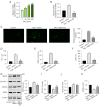Total Astragalus saponins promote ferroptosis in gastric cancer cells by upregulating SIRT3
- PMID: 40104701
- PMCID: PMC11912042
- DOI: 10.21037/tcr-24-1421
Total Astragalus saponins promote ferroptosis in gastric cancer cells by upregulating SIRT3
Abstract
Background: Gastric cancer (GC) is a malignant tumor of the digestive tract originating from the epithelial cells of the gastric mucosa, which is highly invasive and heterogeneous, posing a serious threat to human health. In recent years, ferroptosis, as a novel mode of programmed cell death, has shown potential anticancer effects in tumor therapy. Total Astragalus saponins (TAS), a natural product derived from Astragalus membranaceus, have been shown to possess various pharmacological activities, including anticancer effects. This study aimed to investigate the effects of TAS on GC cells, focusing on the mechanism of action of its regulation of the silent information regulator 3 (SIRT3) in inducing ferroptosis in GC cells.
Methods: We treated SGC-7901 cells with TAS at concentrations of 50, 100, and 200 µg/mL. After TAS treatment, the SGC-7901 cells were transfected with a vector designed to knock down SIRT3 expression. We assessed cell proliferation, viability, and apoptosis using 3-(4,5-dimethylthiazol-2-yl)-2,5-diphenyltetrazolium bromide (MTT assay), colony formation assay, and flow cytometry. SIRT3 expression was measured by real-time quantitative reverse transcription polymerase chain reaction (qRT-PCR). Fe2+, malondialdehyde (MDA), lactate dehydrogenase (LDH), and superoxide dismutase assay kits were used to detect the level of reactive oxygen species (ROS) by fluorescent probe assay. Western blot was used to detect apoptosis-related proteins and SIRT3 protein expression.
Results: TAS dose-dependently inhibited SGC-7901 cell proliferation and viability (P<0.05) and induced apoptosis (P<0.05). TAS promoted the expression of SIRT3 and ACSL4 proteins (P<0.05), inhibited the expression of SLC7A11 and GPX4 proteins (P<0.05), and induced ferroptosis of SGC-7901 cells (P<0.05). Knockdown of the SIRT3 gene attenuated the effect of TAS treatment on ferroptosis (P<0.05).
Conclusions: TAS has therapeutic potential for GC and can effectively inhibit the proliferation and viability of SGC-7901 cells, and the mechanism may be that TAS upregulates SIRT3 to promote the ferroptosis of SGC-7901 cells.
Keywords: Gastric cancer (GC); ferroptosis; silent information regulator 3 (SIRT3); total Astragalus saponins (TAS).
Copyright © 2025 AME Publishing Company. All rights reserved.
Conflict of interest statement
Conflicts of Interest: All authors have completed the ICMJE uniform disclosure form (available at https://tcr.amegroups.com/article/view/10.21037/tcr-24-1421/coif). The authors have no conflicts of interest to declare.
Figures



Similar articles
-
Berberine Protects Against Dihydrotestosterone-Induced Human Ovarian Granulosa Cell Injury and Ferroptosis by Regulating the Circ_0097636/MiR-186-5p/SIRT3 Pathway.Appl Biochem Biotechnol. 2024 Aug;196(8):5265-5282. doi: 10.1007/s12010-023-04825-y. Epub 2023 Dec 28. Appl Biochem Biotechnol. 2024. PMID: 38153651
-
[Anti-tumor mechanism of total saponins of Paridis Rhizoma on inducing ferroptosis of breast cancer MCF-7 cells].Zhongguo Zhong Yao Za Zhi. 2024 May;49(9):2385-2392. doi: 10.19540/j.cnki.cjcmm.20231208.401. Zhongguo Zhong Yao Za Zhi. 2024. PMID: 38812139 Chinese.
-
Red ginseng polysaccharide promotes ferroptosis in gastric cancer cells by inhibiting PI3K/Akt pathway through down-regulation of AQP3.Cancer Biol Ther. 2024 Dec 31;25(1):2284849. doi: 10.1080/15384047.2023.2284849. Epub 2023 Dec 5. Cancer Biol Ther. 2024. PMID: 38051132 Free PMC article.
-
BRIP1 Induced Ferroptosis to Inhibit Glioma Cells and was Associated with Increased Oxidative Stress.Discov Med. 2024 Nov;36(190):2264-2273. doi: 10.24976/Discov.Med.202436190.208. Discov Med. 2024. PMID: 39600281
-
Platycodin D regulates high glucose-induced ferroptosis of HK-2 cells through glutathione peroxidase 4 (GPX4).Bioengineered. 2022 Mar;13(3):6627-6637. doi: 10.1080/21655979.2022.2045834. Bioengineered. 2022. PMID: 35226829 Free PMC article.
References
-
- Si YT, Xiong XS, Wang JT, et al. Identification of chronic non-atrophic gastritis and intestinal metaplasia stages in the Correa's cascade through machine learning analyses of SERS spectral signature of non-invasively-collected human gastric fluid samples. Biosens Bioelectron 2024;262:116530. 10.1016/j.bios.2024.116530 - DOI - PubMed
LinkOut - more resources
Full Text Sources
Miscellaneous
